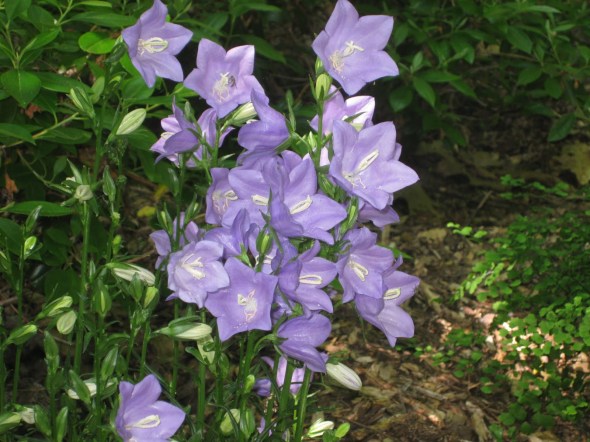Bellflower ~ Campanula Plant Care Guide ~ Varieties

Campanula /kæmˈpæn.juːlə/[2] is one of several genera in the family Campanulaceae with the common name bellflower. It takes its name from their bell-shaped flowers—campanula is Latin for “little bell”.
The genus includes over 500 species and several subspecies, distributed across the temperate regions of the Northern Hemisphere, with the highest diversity in the Mediterranean region east to the Caucasus.
The species include annual, biennial and perennial plants, and vary in habit from dwarf arctic and alpine species under 5 cm high, to large grassland and woodland species growing to 2 metres (6 ft 7 in) tall.
Well-known species include the northern temperate Campanula rotundifolia, commonly known as harebell in England and bluebell in Scotland (though it is not closely related to the true bluebells, and the southern European Campanula medium, commonly known as Canterbury bells (a popular garden plant in the United Kingdom). As well as several species occurring naturally in the wild in northern Europe, there are many cultivated garden species.
The following cultivars have gained the Royal Horticultural Society’s Award of Garden Merit:-
- ‘Birch Hybrid’[3]
- ‘Burghaltii’ (Garden Girls series)[4]
- ‘Joe Elliott’[5]
- ‘Kent Belle’ (Garden Girls series)[6]
The species Campanula rapunculus, commonly known as rampion bellflower, rampion, or rover bellflower, is a biennial vegetable which was once widely grown in Europe for its spinach-like leaves and radish-like roots. The Brothers Grimm’s tale Rapunzel took its name from this plant.
In the UK the National Collection of campanulas is held at Burton Agnes Hall in East Yorkshire and the National Collection of Alpine Campanulas at Langham Hall in Suffolk.
There are 473, including:
Species
|
|
|
Formerly placed here
- Adenophora gmelinii (Spreng.) Fisch. (as C. coronopifolia Schult. or C. gmelinii Spreng.)
- Adenophora khasiana (Hook.f. & Thomson) Collett & Hemsl. (as C. khasiana Hook.f. & Thomson)
- Adenophora liliifolia (L.) Besser (as C. liliifolia L.)
- Adenophora triphylla (Thunb.) A.DC. (as C. tetraphylla Thunb. or C. triphylla Thunb.)
- Azorina vidalii (H.C.Watson) Feer (as C. vidalii H.C.Watson)
- Borago pygmaea (DC.) Chater & Greuter (as C. pygmaea DC.)
- Legousia pentagonia (L.) Druce (as C. pentagonia L.)
- Platycodon grandiflorus (Jacq.) A.DC. (as C. glauca Thunb. or C. grandiflora Jacq.)
- Specularia speculum A.DC. (as C. speculum-veneris L.)
- Triodanis perfoliata (L.) Nieuwl. (as C. perfoliata L.)
- Wahlenbergia linarioides (Lam.) A.DC. (as C. linarioides Lam.)
- Wahlenbergia marginata (Thunb.) A.DC. C. gracilis G.Forst. or C. marginata Thunb.)
- Wahlenbergia undulata (L.f.) A.DC. (as C. undulata L.f.)[8]
************
How to Care for a Campanula Plant

Overview
Campanula also is known as bellflower. There are approximately 300 varieties of campanula, including annuals, biennials and perennials. Their trumpet-shaped flowers are white, rose, blue or purple. The different varieties grow from 3 inches high to about 4 feet high. The shorter varieties make good ground cover for areas that do not receive foot traffic.
Step 1
Grow campanula in full sun to partial shade. The shorter the variety, the less sun required. Campanula likes the dappled shade of deciduous trees and makes an excellent ground cover beneath them. It also benefits from the shade tree’s roots, which loosen the soil as they grow deep underground in search of moisture. The roots of campanula will do the same thing.
Step 2
Grow campanula in unimproved soil. It grows well in any type of soil, except heavy clay or waterlogged, marshy soil.
Step 3
Water campanula only in times of extreme drought. Its deep-growing roots will seek out and find water deep underground and will thrive with only natural rainfall.
Step 4
Cultivate to remove weeds as campanula does not favorably compete with them, especially lawn grasses. Put down a mulch of hay or straw about 2 inches thick to suppress the growth of weeds and reduce competition for water and nutrients.
Things You’ll Need







Leave a comment